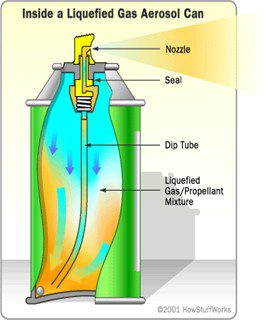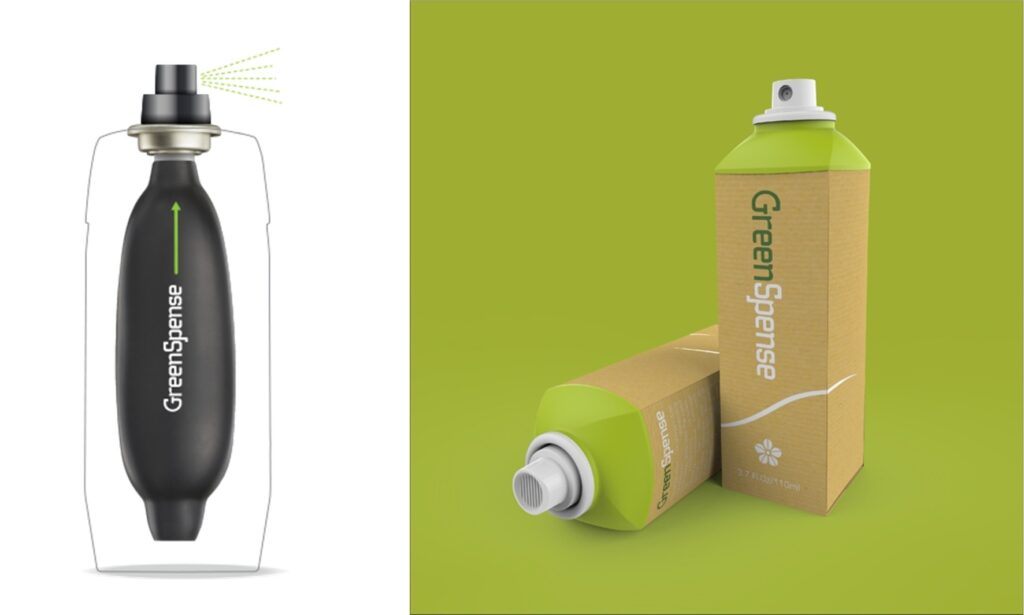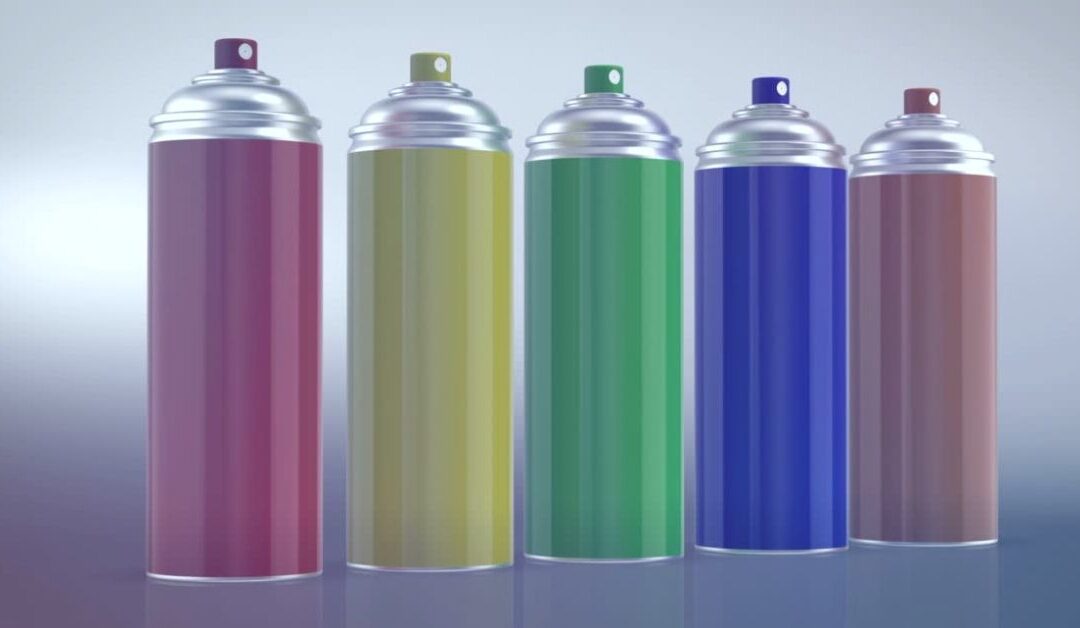Table of Contents
Aerosol paints, popularly known as spray paints, have become indispensable for use in various industries, crafts, and everyday life. They offer a convenient, portable, and efficient way to apply coatings, delivering smooth finishes without brushes or rollers.
However, aerosol paints also pose unique challenges in terms of environmental impact, regulatory compliance, and formulation. This article explores the science and technology behind aerosol paints, including can design, propellant chemistry, air quality regulations, formulation hurdles, and emerging new innovations to traditional spray paint can designs.
Anatomy of an Aerosol Paint Container
Chemists who formulate spray paints must know a lot more than just how to put the product together. They must also have knowledge about the container and how it works so when the product is sprayed, it delivers the right finish.
Traditional Aerosol Systems
The familiar spray paint can is a marvel of engineering, designed to safely store and deliver pressurized liquid coatings. Understanding the can’s components is essential to appreciate the constraints and opportunities in formulating aerosol paints (see Figure 1). Key components include:
- Can body: Typically made of tin-plated steel or aluminum, the can must withstand internal pressures up to 6-8 bar (~90-120 psi) without leaking or rupturing. The interior is often lined with a resin-based coating to prevent corrosion from the paint or propellant.
- Nozzle/valve/actuator: The valve assembly at the top regulates the release of the product when pressed. The actuator (the plastic button the user presses) channels the product through a nozzle orifice to atomize it into a fine spray.
- Dip tube: A plastic tube extends to the bottom of the can, allowing liquid paint to be drawn up when the can is upright.
- Propellant: Compressed gas or liquefied gas pressurizes the can and drives the paint out through the nozzle.

(Source: www.howstuffworks.com)
Additional properties are necessary for optimal results and a positive user experience. The system must remain stable over long storage periods, deliver consistent spray patterns, and tolerate varying temperatures and handling conditions.
Bag-on-Valve (BOV) Systems
BOVs are multi-protective packaging systems consisting of an aerosol valve, vacuum bag, metal container, and an actuator button (see Figure 2). The liquid product and propellant are packaged separately in their respective containers. This reduces the complexity of the formulation and does not release the propellant during use, reducing the impact on safety and the environment. It is considered a safe aerosol packaging technology because the gas in the BOV package is usually nitrogen or compressed air.

(Source: JR Packing.com)
The bag is welded to the aerosol valve and then shoved inside the can, which is made of either aluminum or steel. The product is squeezed into the bag, while the gas propellant is filled into the space between the can and the bag. When the actuator is pressed, the product is squeezed out of the bag by the propellant.
Because of the separation of the product and the propellant, liquids, creams, and gels can all be dispensed with BOV technology. Examples of typical products that use BOV technology include liquid fire extinguishers, air fresheners, odor eliminators, car care products, disinfectants, furniture polish, and cleaners.
One thing to remember is that the cost of BOV packaging technology averages about 15-25% more per unit than traditional aerosol packaging. Even given their higher cost, however, using BOV technology offers several benefits over traditional aerosol can systems, including:
- The formulation does not have to be altered to accommodate propellant
- Longer shelf life for oxygen-sensitive products
- Suitable for both liquid and viscous products
- Can be used with standard actuators and aerosol cans
- 100% product emptying; no product left in the can
- More environmentally friendly
Generally, BOV technology does not work for products that need to be shaken before use. Thus, paints and coatings tend to use more traditional aerosol packages. Only very low-viscosity products or moisture-cure coatings would be considered suitable candidates for BOV packaging systems.
Propellant Chemistry: How the Paint Gets Out
Propellants are critical to aerosol paint performance because they pressurize the can and atomize the paint. They are selected based on pressure requirements, solubility with paint components, flammability, environmental impact, and cost. Types of propellants are highlighted below.
Liquefied Gases
- Hydrocarbons: Propane, butane, and isobutane are common because they are effective and inexpensive. However, they are highly flammable and contribute to VOC emissions.
- Dimethyl ether (DME): Often used for its good solvency and atomization properties but also flammable and a VOC
- HFCs: Used in specialty applications where non-flammability is critical but being phased out for their high global warming potential
Compressed Gases
- Carbon dioxide (CO₂): Non-flammable and environmentally benign but limited by its relatively low vapor pressure
- Nitrogen (N₂): An inert, dry gas that is also environmentally safe
- Compressed air: Readily available and safe but offers lower pressure and inconsistent spray performance compared to liquefied gases
As manufacturers move away from flammable hydrocarbons and greenhouse-gas HFCs, CO₂, N₂, and compressed air have attracted attention as alternatives for some types of aerosol products. These materials have low toxicity and minimal environmental impact, and they are not classified as VOCs. In addition, they are non-flammable and both readily available and inexpensive, providing attractive advantages.
Compressed gases are not without challenges, however. Lower vapor pressure means that cans often have to withstand higher fill pressures, which can increase material and manufacturing costs. Pressure drop-off can also be more significant over the life of the can, leading to inconsistent spray as the can empties.
Larger can volumes or additional internal components (like bags or pistons) are sometimes needed to improve performance. For many applications, these gases work best when combined with specialized can designs (e.g., BOV systems) to maintain spray quality.
Air Quality Regulations and Environmental Concerns
Like many other coatings, aerosol paints contain volatile organic compounds (VOCs) that contribute to ground-level ozone formation and smog. Because of this, they are tightly regulated in many regions to reduce their impact on air quality.
Regulatory Landscape
In the United States, the Environmental Protection Agency (EPA) regulates VOC emissions under the Clean Air Act; California’s Air Resources Board (CARB) has even stricter standards for consumer products, including aerosol paints. The European Union enforces VOC limits under the Paints Directive (2004/42/EC). Many other countries follow similar guidelines, often specifying a maximum VOC content per liter or per can of paint.
Impact on Formulation
These regulations drive manufacturers to reduce solvent content, use lower-VOC resins, or shift toward water-based technologies (more on this to come). However, lower-VOC formulations often come with challenges in terms of sprayability, drying time, and finish quality.
In addition, propellants themselves bring environmental considerations:
- Chlorofluorocarbons (CFCs) were banned decades ago due to their ozone-depleting properties.
- Hydrofluorocarbons (HFCs), while ozone safe, are potent greenhouse gases and are now being phased down globally under the Kigali Amendment.
Formulating Water-Based Aerosol Paints
In response to regulatory and environmental pressures, manufacturers have developed water-based aerosol paints. These products offer significant reductions in VOC emissions but present their own technical challenges, including:
- Stability: Water-based paints are more prone to microbial growth and separation during storage.
- Corrosion: Water is inherently corrosive to metal cans, requiring robust internal coatings.
- Drying time: Water evaporates more slowly than organic solvents, which can extend drying times.
- Freezing: Water-based products can be damaged at low temperatures during transport or storage.
To overcome these issues, formulators use advanced resins, co-solvents, surfactants, and preservatives; cans are also lined with high-performance epoxy-phenolic coatings. Despite these hurdles, water-based aerosols have found success in several markets, particularly where regulatory compliance is critical.
The cost-of-goods (COG) for water-based aerosol paints is about $0.40-0.45 more per unit compared to their solvent-based equivalents (see Table 1). The difference comes in using lined containers, water-compatible propellants like DME, and the resin composition cost.
| Cost Component | Solvent-Based (Propane/Butane) | Water-Based (DME) | Difference |
| Base formulation (resin, pigments, additives) | $1.80 – 2.20 | $2.20 – 2.60 | + $0.40 |
| Propellant | $0.078 – 0.096 | $0.126 – 0.168 | + $0.05 – 0.07 |
| Can + valve + actuator | $0.50 – 0.65 | $0.50 – 0.65 | 0 |
| Filling & assembly | $0.25 – 0.35 | $0.25 – 0.35 | 0 |
| Waste handling / compliance | $0.05 – 0.08 | $0.02 – 0.04 | – $0.03 |
| Total per unit COG | $2.68 – 3.39 | $3.07 – 3.78 | ≈ + $0.39 – 0.46 |
(Source: ChemQuest, imarcgroup.com, market.us (aerosol propellants), fortunebusinessinsights.com)
New Ways to Spray: Beyond Propellants
Traditional aerosol cans have inherent drawbacks, including the use of pressurized, often flammable or greenhouse-contributing propellants, as well as metal cans that are energy-intensive to produce. This has inspired innovations in propellant-free dispensing technologies, one of the most notable being Greenspense™ Eco-Drive™ technology.
Greenspense, an Israeli startup, developed a continuous dispensing system that requires no propellant. The company received funding from the EU’s Horizon 2020 SME Instrument Phase II and earned the 2015 European New Product Innovation Award in Sustainable Packaging. The resulting Eco-Drive™ replaces the internal pressure source with a patented mechanical mechanism (a flexible bladder or elastomeric material that applies constant pressure to the contents).

As the product is dispensed, the mechanism contracts, maintaining consistent pressure and spray quality. The can fully evacuates its contents. The system is lightweight, recyclable, and eliminates VOC emissions since there are no propellants required.
The benefits of this system include:
- Compatible with a wide range of formulations, including water-based and sensitive materials
- Versatile sustainable packaging choices that reduce environmental footprint; outer packaging can be any material (plastic, cardboard, metal glass) in any shape (including reusable eco-friendly packages made from recycled materials)
- High-pressure continuous airless dispensing, resulting in smooth spraying at a continuous flow rate
- Works with standard 1-inch valves and actuators; uses standard filling lines/equipment without retooling
- Supply chain cost efficiency; shipping and storage costs do not require flammability warnings or special handling requirements
Greenspense’s technology reimagines aerosol delivery by replacing traditional, hazardous propellants with a patented elastomer-based system. This alternative has the potential to upend the aerosol industry by making the product safer, greener, and more versatile while delivering equal or better functionality for end users.
Final Thoughts
Aerosol paints have evolved considerably from their mid-20th-century origins, becoming more sophisticated and environmentally conscious. Innovations in can design, propellant chemistry, and formulation have enabled compliance with increasingly stringent air quality regulations while meeting consumer demands for convenience and performance.
That said, the future of aerosol paints is likely to look very different. Stricter VOC and greenhouse gas regulations are pushing manufacturers toward water-based formulations and non-flammable, non-VOC propellants like CO₂ and N₂. New technologies like Greenspense™ Eco-Drive™ offer a way to eliminate propellants entirely, reducing both environmental impact and safety risks. As the coatings industry continues to innovate, aerosol paints remain a fascinating example of how engineering, chemistry, and environmental stewardship can intersect to produce practical, high-performance solutions.
To learn more, reach out to the author at vscarborough@chemquest.com.
Read in PCI.
For Further Reading
- California Air Resources Board (CARB): Consumer Products Program
- U.S. EPA: Volatile Organic Compounds (VOCs) and Ozone
- Greenspense Ltd.: Eco-Drive Technology Overview
- European Coatings Handbook: Aerosols & Spray Systems

